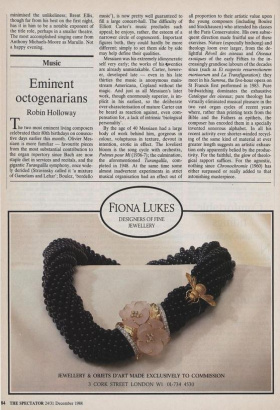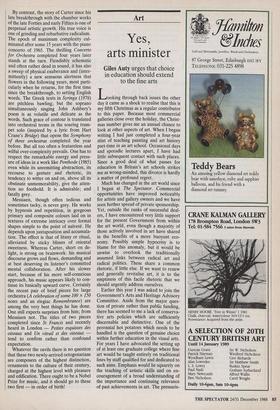Music
Eminent octogenarians
Robin Holloway
he two most eminent living composers celebrated their 80th birthdays on consecu- tive days earlier this month. Olivier Mes- siaen is more familiar — favourite pieces from the most substantial contribution to the organ repertory since Bach are now staple diet in services and recitals, and the gigantic Turangalila symphony, once wide- ly derided (Stravinsky called it 'a mixture of Gamelans and Lehar'; Boulez, 'bordello
music'), is now pretty well guaranteed to fill a large concert-hall. The difficulty of Elliott Carter's music precludes such appeal; he enjoys, rather, the esteem of a narrower circle of cognoscenti. Important figures both, they could hardly be more different; simply to set them side by side may help define their qualities.
Messiaen was his extremely idiosyncratic self very early; the works of his 4,wenties are already unmistakable. Carter, howev- er, developed late — even in his late thirties the music is anonymous main- stream Americana, Copland without the magic. And just as all Messiaen's later work, though enormously superior, is im- plicit in his earliest, so the deliberate over-characterisation of mature Carter can be heard as reaction against, even com- pensation for, a lack of intrinsic 'biological personality'.
By the age of 40 Messiaen had a large body of work behind him, gorgeous in colour, voluptuous in texture, devout in intention, erotic in effect. The loveliest bloom is the song cycle with orchestra, Poemes pour Mi (1936-7); the culmination, the aforementioned Turangalila, com- pleted in 1948. At the same time some almost inadvertent experiments in strict musical organisation had an effect out of all proportion to their artistic value upon the young composers (including Boulez and Stockhausen) who attended his classes at the Paris Conservatoire. His own subse- quent direction made fruitful use of these exercises. Nature (especially birdsong) and theology loom ever larger, from the de- lightful Reveil des oiseaux and Oiseaux exotiques of the early Fifties to the in- creasingly grandiose labours of the decades since (such as Et exspecto resurrectionem mortuorum and La Transfiguration): they meet in his Summa, the five-hour opera on St Francis first performed in 1983. Pure birdwatching dominates the exhaustive Catalogue des oiseaux; pure theology has virtually eliminated musical pleasure in the two vast organ cycles of recent years where, rather than printing texts from the Bible and the Fathers as epithets, the composer has encoded them in a specially invented sonorous alphabet. In all his recent activity ever shorter-winded recycl- ing of the same kind of material at ever greater length suggests an artistic exhaus- tion only apparently belied by the produc- tivity. For the faithful, the glow of theolo- gical rapport suffices. For the agnostic, nothing since Chronochromie (1960) has either surpassed or really added to that astonishing masterpiece. By contrast, the story of Carter since his late breakthrough with the chamber works of the late Forties and early Fifties is one of perpetual artistic growth. His true voice is one of grinding and rebarbative radicalism. The epoch of maximum complexity cul- minated after some 15 years with the piano concerto of 1965. The thrilling Concerto for Orchestra completed four years later stands at the turn. Fiendishly schematic and often rather dead in sound, it has also a sweep of physical exuberance and (inter- mittently) a new sensuous alertness that flowers in the following years, most parti- cularly when he returns, for the first time since the breakthrough, to setting English words. The Greek texts in Syringa (1978) are pitchless bawling; but the soprano simultaneously singing John Ashbery's poem is as volatile and delicate as the words. Such grace of contour is translated into orchestral terms in the soaring trum- pet solo (inspired by a lyric from Hart Crane's Bridge) that opens the Symphony of three orchestras completed the year before. But all too often a featureless and wilful over-complexity prevails. One has to respect the remarkable energy and press- ure of ideas in a work like Penthode (1985) even while its unremitting abstraction, its recourse to gesture and rhetoric, its tendency to witter on and on, above all its obstinate unmemorability, give the atten- tion no foothold. It is admirable; and fatally grey.
Messiaen, though often tedious and sometimes tacky, is never grey. He works by hypnosis and repetition, in gorgeous primary and composite colours laid on in textures of extreme intricacy over formal shapes simple to the point of naïveté. He depends upon juxtaposition and accumula- tion. The effect is that of litany or ritual, alleviated by sticky blisses of oriental sweetness. Whereas Carter, short on de- light, is strong on brainwork: his musical discourse grows and flows, demanding and at best deserving its listener's committed mental collaboration. After his slower start, because of his more self-conscious approach, his music appears likely to con- tinue its basically upward curve. Certainly the recent pair of brief pieces for large orchestra (A celebration of some 100 x 150 notes and an elegiac Remembrance) are among the very best things he has done. One still expects surprises from him; from Messiaen not. The titles of two pieces completed since St Francis and recently heard in London — Petites esquisses des oiseaux and Un vitrail et des oiseaux — tend to confirm rather than confound expectation.
Whatever the cavils there is no question that these two newly-arrived octogenarians are composers of the highest distinction, ornaments to the culture of their century, charged at the highest level with pleasure and edification. There ought to be a Nobel Prize for music, and it should go to these two first — in order of birth!











































































































 Previous page
Previous page